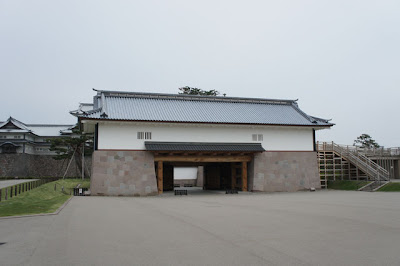We passed the Ishikawa-ken Shiinoki Culture Complex on our way to Kanazawa Castle and Kenroku-en.

The rebuilt wall and moat of the Kanazawa Castle.

The Ishikawa Bridge connected Kanazawa Castle and Kenroku-en.

The wall next to the Ishikawa-mon Gate was under renovation.

The newly rebuilt Kahoku-mon Gate of Kanazawa Castle was just over one year old.

Archeological digging site next to the Tsuru-no-maru Square at Kanazawa Castle.

The narrow Gojikken Nagaya at Kanazawa Castle.

No metal or nails were used for constructing the wooden structure of Gojikken Nagaya.

The view of the San-no-maru Square from the watchtower of Gojikken Nagaya.

This fountain at Kenroku-en was said to be the very first one in Japan.

The tea house next to Kenroku-en’s Hisaho-ike Pond.

The boat-shaped pavilion at Kenroku-en.

The blossoming flower-de-luce near the Hanami bridge at Kenroku-en.

The Japanese garden of Seison-kaku, a villa not part of Kenroku-en.

The Karasaki Pine at a side Kasumika-ike Pond was one of the famous scenes of Kenroku-en.

The Kotoji stone lantern was said to be the symbol of Kenroku-en.

Kanazawa, literally marsh of gold, was said to be named after wells for washing gold.

The Ishikawa-ken History Museum located inside an old brick warehouse.

The silent alleys of the community for low class samurais.

The ditch that surrounded the community for low class samurais.

The gate of one of the low class samurai’s house

The Next Day